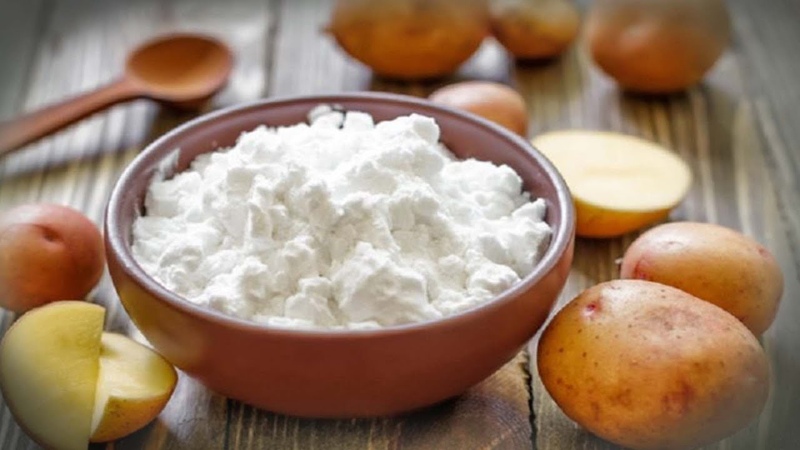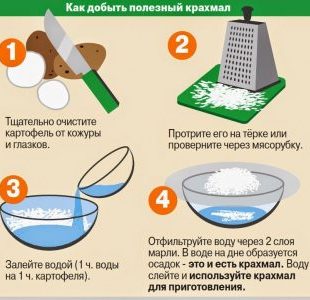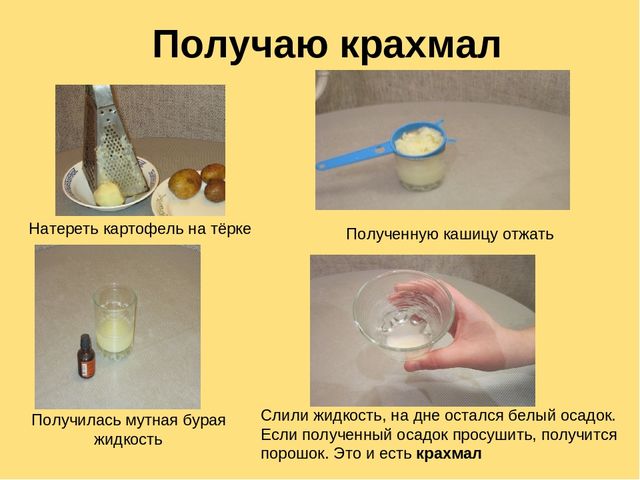How to make potato starch at home
Starch - a product needed in any kitchen, it is sold in every grocery store. If you wish, you can prepare a useful product at home with your own hands, without chemical additives used in its industrial production. Getting a pure product is not a very laborious process.
We will tell you how to make potato starch at home in the article.
The content of the article
Homemade potato starch
If, after buying and sorting a large volume of potatoes, there are many mechanically damaged and partially spoiled tubers, do not rush to throw them away - make homemade starch out of them with your own hands.
The process of obtaining potato starch is simple: there are tools at hand in any kitchen, and besides potatoes, you only need a small amount of water.

Advantages and disadvantages
The main advantage of homemade potato starch is that it is environmentally friendly, without the use of chemical additives. The home product is not as crisp as the store-bought product, has a natural yellowish tint. This is due to the fact that blue food coloring is mixed into the starch prepared for mass consumption, due to which the powder becomes white.
Disadvantages of self-prepared starch:
- high consumption of potatoes used for preparing starch - from 2.6-2.8 kg of tubers, only 100 g of dry powder is obtained;
- it takes a long time to prepare a homemade product, drying takes up to 72 hours;
- to speed up the drying process in the room, it is required to maintain the optimum temperature and humidity - at high humidity, the powder will not dry to the desired consistency.
Which potato is right

To prepare the product at home, varieties with high starch content – 17-20%.
Such indicators are possessed by varieties: Aurora (17.5%), Elizabeth (18%), Odysseus (17%), Zhuravinka (19%), Lorch (20%), Scarb (17%), Story (17%), Voltman (19%), Bashkir (19.7%).
Preference is given to mid-season varieties, since during the summer season their tubers have time to fully ripen and accumulate a sufficient amount of glucose, which is converted into starch during photosynthesis.
Tubers of late-ripening varieties, which did not have time to ripen before the onset of cold weather, are harvested insufficiently ripe, the starch content in them is below normal.
Selection and preparation
Experienced gardeners have noticed that more starch is contained in tubers with brown skin and yellowish flesh - they crumble during cooking. Suitable for preparing the product are young, freshly dug potatoes and old, soft, even completely wrinkled, mechanically damaged ones. Frozen, rotten tubers with dark spots in the core are not suitable. Small, unripe potatoes are also not suitable - they contain no more than 10-12% starch.
To determine which tubers contain the maximum amount of starch, they are cut and rubbed with the pulp on the palm. If, after drying, a dusting effect is felt on the hand, and after squeezing the palm, a characteristic creak is heard, such tubers contain a large amount of pure substance.
Another option: the cut tubers are left for 25-30 minutes, after a while a starchy film forms on the cleaned surface. The higher the content of the nutrient in root crops, the faster it is formed.
Before preparing the product, vegetables are thoroughly washed, sprouts are removed, peeled, and damaged areas are cut off.
How to make potato starch at home
Making a product at home is a simple process. You only need the right amount of potatoes and free time. The starch has no taste, so the variety you choose doesn't matter.
What is necessary
To make the powder you will need:
- potatoes;
- 2 transparent containers;
- any grinder - grater, meat grinder, vegetable cutter, juicer, blender;
- clean cold water;
- gauze or fine sieve;
- napkins or paper towels.
Step-by-step instruction
Cooking technology is simple:
- Wash tubers with running water. Remove damaged areas, rot. Peel the potatoes. You can use tubers unpeeled, but thoroughly washed with a clean kitchen sponge - in this case, the powder will turn out to be darkish.
- Chop the peeled vegetables with improvised means (grater, meat grinder or others) until they are mushy. When grinding, the integrity of the cells is violated, which allows the starch to be released freely.

- Pour the potato mass with cold water, stir. With stirring, starch from the potato mass is released into the water and floats in the form of a suspension. The use of hot water is not allowed, since starch tends to dissolve immediately in it.
- Leave the mass for 20 minutes for the useful product to settle to the bottom of the container. Light sediment will be clearly visible through the transparent walls of the container.
- Put a fine sieve on the second container, pour the resulting mass onto it. Squeeze the potato gruel by hand and leave it on a sieve for 15 minutes until the juice completely drains. After that, the vegetable mass is removed. The liquid drained into the container will gradually acquire a brown tint.
- When the released starch settles to the bottom of the container, drain most of the turbid water. A dark sediment will remain at the bottom.
- Pour the sediment with cold clean water, wait 10-15 minutes for the starch to settle to the bottom. The water will not be as dark as during the first settling.
- Drain the cloudy layer, fill the sediment with a new portion of water. Repeat the procedure until the water becomes clear, transparent, and the precipitate turns white.
- Line a tray or baking sheet with 4-5 layers of napkins or paper towels. Stir the sediment with a small amount of the remaining water and quickly, until it settles again, pour it onto a layer of paper. The paper towels will absorb the excess liquid and leave the starch on the surface. The bottom wet layers of towels should be changed to dry ones until all the liquid is absorbed.
- Spread the white precipitate evenly over the surface of the paper, leave to dry at room temperature.
- To speed up the drying process, spoon the starch from damp paper onto a sheet of foil. Stir the mass periodically with a spoon so that it dries evenly.
The product is dried in a room with low air humidity. The substance is periodically kneaded with your fingers until the lumps are crushed, mixed, leveled with a thin layer on the surface of the foil. You can determine the drying of a substance by touch, when kneading it with your fingers, it will crunch softly. The product is also rolled with a rolling pin, if a crunch is heard, the starch is completely dry.
Reference. It will take 40-50 minutes to prepare the raw materials; it takes about 72 hours to dry the powder at room temperature.
The resulting homemade starch is poured into a plastic food container or a glass jar with a hermetically sealed lid to prevent condensation. It is recommended to store the container in a dry place.

Cooking methods
You can grind potatoes with a coarse grater. Vegetables are pre-peeled, cut into small pieces.
You can use a meat grinder to turn the tubers into a homogeneous mass.Peeled vegetables are first cut into pieces, then passed through the device. In this case, the vegetable mass will not only come out of the meat grinder, but potato juice will also flow out at the same time.
If the drying process of starch needs to be accelerated, use an oven. To do this, the white sediment that has sunk to the bottom of the container is laid out in a thin layer on a baking sheet covered with thick clean paper, placed in the oven. The thinner the layer, the sooner the moisture will evaporate. The temperature in the oven should not exceed + 40 ° С. It takes several hours to completely dry the product.
Attention! At temperatures over + 40 ° C, starch turns into a paste.
When the powder on the baking sheet becomes crumbly, knead it with a rolling pin to grind the resulting lumps or simply rub the grains with your fingers.
For home baking, the finest powder consistency is used. To finally bring the resulting product to the state of powder, it is ground in a coffee grinder.
Conclusion
A simple way to make potato starch yourself at home allows you to get a better quality product. Starch prepared with your own hand will not cause doubts about its naturalness. This process does not require a lot of costs: from 1 bucket of potatoes, 1.3-1.5 kg of homemade pure product is obtained.